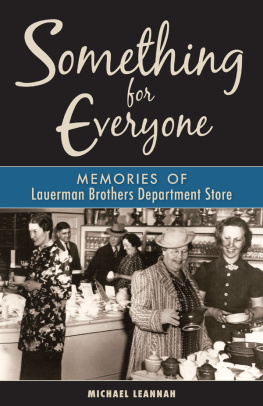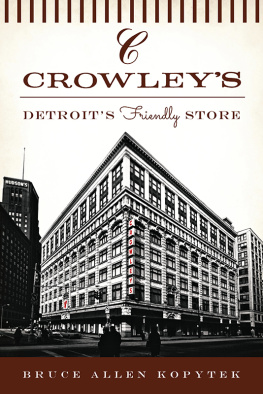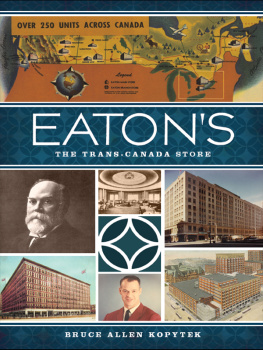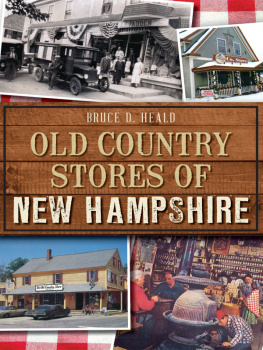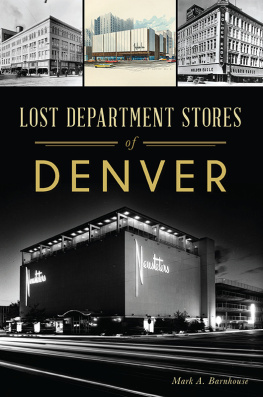
IMAGES
of America
BULLOCKS
DEPARTMENT STORE
ON THE COVER: Broadway at Seventh Street was a lonesome corner when Bullocks first occupied it. With the exception of the Lankershim Hotel, there were no large structures in the vicinity. It was too far down Broadway, too far from the retail district. P.G. Winnetts son asked how they got all the people off the street when this photograph was taken. Oh, that was easy, replied Winnett. We just asked the two or three who were passing to step aside. The store is shown around January 1, 1907.
IMAGES
of America
BULLOCKS
DEPARTMENT STORE
Devin T. Frick

Copyright 2015 by Devin T. Frick
ISBN 978-1-4671-3296-1
Ebook ISBN 9781439650424
Published by Arcadia Publishing
Charleston, South Carolina
Library of Congress Control Number: 2014949518
For all general information, please contact Arcadia Publishing:
Telephone 843-853-2070
Fax 843-853-0044
E-mail
For customer service and orders:
Toll-Free 1-888-313-2665
Visit us on the Internet at www.arcadiapublishing.com
To all who fondly remember, shopped at, or worked for Bullocks and Bullocks Wilshire.
CONTENTS
ACKNOWLEDGMENTS
I was born and raised in California and have always had a great fondness for the states history, culture, and people. Over the years, I have been extremely fortunate to produce museum exhibits, art shows, and publications on subjects related to the Golden State. This book is near and dear to me, as Bullocks was so very much a part of my life. My grandmother purchased items from Bullocks for her home in the 1930s. She was also a proofreader for the Los Angeles Examiner newspaper, proofing many news articles that included society happenings and events featuring Bullocks Downtown and Bullocks Wilshire. My mother shopped at most of the major stores: J.W. Robinsons, The Broadway, May Company, I. Magnin, and Bullocks. For me, Bullocks and I. Magnin set themselves apart from the rest. Bullocks Westwood, Santa Ana, La Habra, and Pasadena were beautiful stores with equally stunning merchandise. Hand-blown glass ornaments from Russia, Waterford crystal from Ireland, Royal Doulton flambe and china from England, fine sheets and bedding, and, of course, quality clothing, were always bought at Bullocks.
No project, large or small, can be done alone. I wish to thank many individuals, libraries, historical societies, universities, and other institutions. My mother, Jean Frick, is an accredited librarian and USC alumni. Interviews and assistance came from Richard Martinez, Max Pierce, Lisa Ackerman, Darlene Quinn, David Galvan, and numerous friends. Larry Frick assisted with technical support.
Los Angeles Public Library, Pasadena Public Library, Santa Ana Public Library, Palm Springs Public Library, San Francisco Public Library, Costa Mesa Historical Society, Palo Alto Public Library, Bullocks employee publications from various years, P.G. Winnetts Store Objectives, Bullocks store interviews, California magazine, Architect & Engineer, Architectural Forum, Architectural Record, California Arts, the Los Angeles Times, the Los Angeles Examiner, Pasadena Star News, Womens Wear Daily, and Orange County Illustrated all provided information and images.
All images in this book were collected over many decades from various sources. All are in the public domain, originating in the newspapers, magazines, and community publications previously listed. Credited photographs come from Mott Studio of Los Angeles, Maynard Parker, Julius Shulman, Jerome K. Muller, and others. All images, unless otherwise noted, are from the authors collection.
FOREWORD
Perhaps no other department store reflects the 20th century more than Bullocks. Created in 1907 by a successful Los Angeles merchant named Arthur Letts, it was a speculative venture, seemingly independent, yet not. If it failed, it bore the name of the employee trusted to run it.
Bullocks was a success. It was located four blocks south of Lettss The Broadway Department Store. It would be five years after Lettss 1923 death before John G. Bullock and a trusted group of investors could wrest independence and full ownership. They did, and began work on a suburban branch store only a few miles west of downtown that would be unique in design, merchandising, and name from the main store, which had expanded to multiple buildings. Bullocks Wilshire opened four weeks before the October 1929 stock market crash. The store was an instant hit with millionaires and movie stars for clothing and accessories, and the fifth floor tea room would become a destination for countless ladies who lunched, regardless of social status.
In the fall of 1933, John Bullock, now a civic leader, died unexpectedly. P.G. Winnett took charge, and Bullocks prosperity continued. In 1964, Bullocks Inc. was acquired by Federated Department Stores. Around 1974, the Wilshire store and three others were spun off into an apostrophe-less division called Bullocks Wilshire, and the Bay Area had a short-lived Bullocks North division.
By 1988, Bullocks, along with sister divisions Bloomingdales and I. Magnin & Co., were considered Federateds crown jewels both by shoppers and professionals alike. About that time, Federated became the target of a hostile takeover, resulting in Bullocks being sold to R.H. Macy & Co., and the headquarters moved to Atlanta. In 1996, Bullocks and its original parent company The Broadway were re-branded as Macys.
The motto To Build a Business That Will Never Know Completion remains above the doorway of Bullocks Wilshire. This book by Devin T. Frick remains true to that statement.
Max Pierce, former Bullocks and Federated executive,

John Bullock and his team strove to serve their patrons only the best. Every promise to a customer was a sacred obligation. Regardless of cost, the satisfaction of the patron came first. Cheerfulness and sincerity exuded from every employee and every department. Bullocks strove to create an atmosphere that would place it above the ordinary level of the average store, where friendship would be expressed through notable service. The store developed a motto that lasted as long as the company did.
INTRODUCTION
The story of Californias Bullocks department stores and the Bullocks Wilshire specialty stores begins with its founder, John Gillespie Bullock, who was born in the Paris province of Ontario, Canada, on January 14, 1871. When he was only two years old, his father, Joseph, a railroad man of Scotch ancestry, passed away, leaving his mother to take care of the family. When he was 11, John had to leave school in order to help with the familys needs, his first job being a stock boy at Rheders Grocery for $2 a week.
Over time, Johns responsibilities at Rheders increased, and he was given a delivery wagon. With great pride in this promotion, he took to the streets, soliciting orders and delivering them. Bullock zealously guarded against any errors. Years later, he revealed, it was my ambition while driving that delivery wagon to have, some day, as big a store as Rheders.
At the age of 20, John received a letter from an uncle who lived in California, extolling the virtues and opportunities available out West. It lit a fire within Bullock. Sensing her sons desire, Johns mother consented to the trip, giving him $150 from her small savings. In January 1896, Bullock made it across two countries and one large continent. Upon his arrival in Los Angeles, the thrifty young man deposited his money in the Citizens National Bank. However, finding work in his new city was a difficult matter.
Next page

